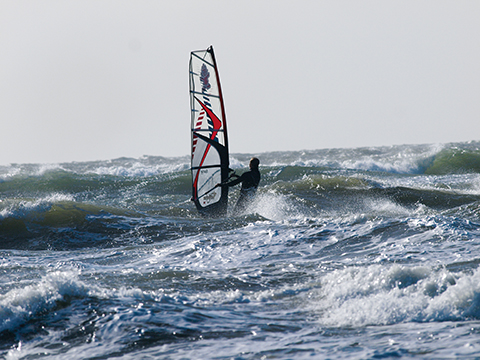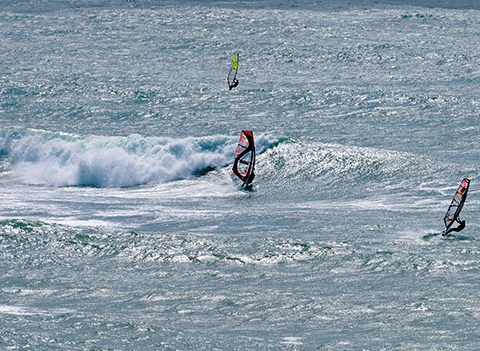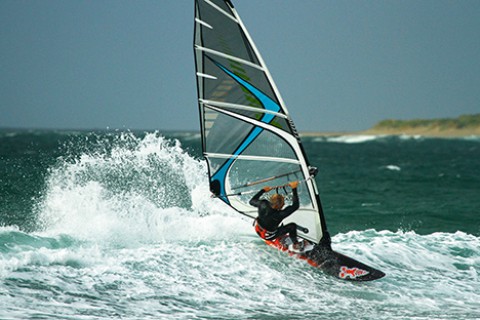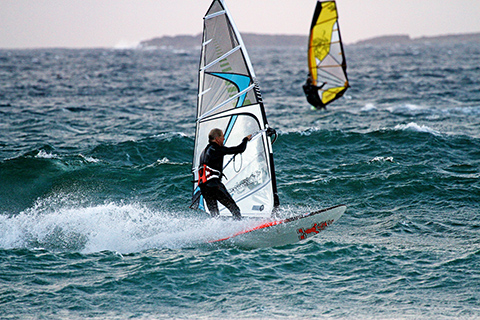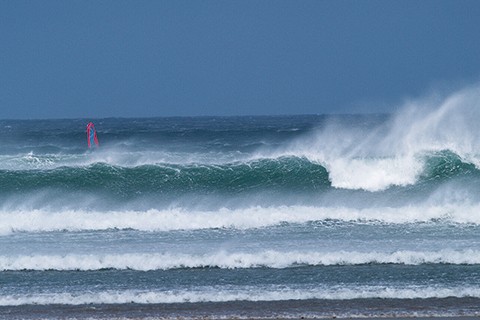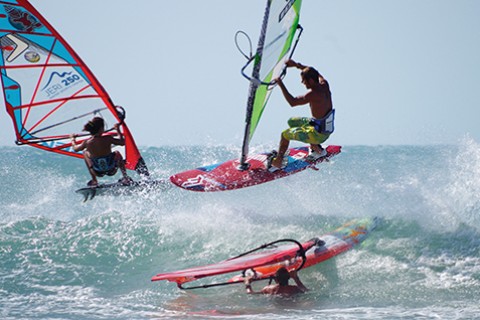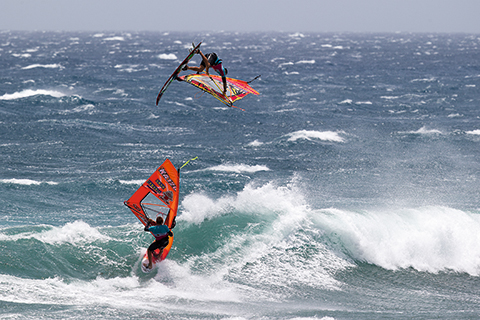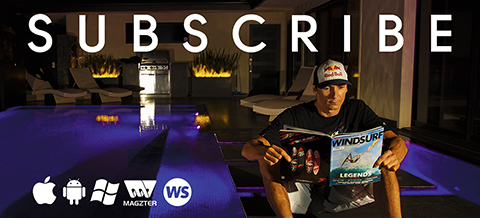PETER HART – WAVE CONDITIONS DIRECTORY
One day a hero, the next day a clown – that’s the way it is in the waves … but why? In an attempt to clarify and console, Peter Hart describes how different combinations of wind and swell direction alter the nature of the challenge physically, mentally and technically.
Words Peter Hart // Photos Hart Photography, Rophina Yeld, JC / pwaworldtour.com & getwindsurfing.com
Asked what you imagine to be the most challenging aspect of running wave clinics, you might say it’s constantly having to repair kit or the nursing of a perma-hangover from endless post match beers. You’d be wrong. Kit is so robust that there are surprisingly few breakages these days. And beers are never a problem because wave sailing makes you very thirsty. The real challenge lies in managing expectations. In all fields of windsurfing people tend to have a tick-box mentality. “How did you get on today?”
“Rubbish. I only made 4 gybes and yesterday I did 10.” But crying into their cocktail they failed to compute that ‘today’ a 20° shift in the wind direction had doubled the size of the chop and made gybing at least four times as difficult. Using that algorithm, they’d actually improved. People are notoriously bad at relating performance to the conditions – and especially in wave-sailing where there’s an added mountain of variables.
Climb inside the heads of the keen amateur and pro as they survey the same scene before a session in the swells and you will hear two very different mental commentaries. The amateur. “Must do forward loop … must do forward loop …must do forward loop.”
The pro. “High tide – wind fluffy inshore, waves jacking up suddenly on the shelf close to the beach so timing for jumps really difficult – no time to get up to full planing speed and waves too steep for forward loops – may get in a ‘backie’ but focus on riding. Rig down a bit – wind slightly offshore so could get some cracking aerials on the inside section. Wave very steep – need tight, snappy bottom turn so twinser set-up might work best. Afternoon wind due to swing more onshore. As tide drops and water clears the inside bank, the waves will space out and get ‘slopier’ – could be great jumping.” The amateur had a pre-set agenda that he was going to follow whichever conditions he encountered. In his mind, wind and waves equal jumps (they don’t). If you can jump surely you can do a forward? If you can’t you’re a wuss. And so due to his fixation, he suffers another failed session trying a move that was pretty much impossible given the situation.
The pro meanwhile set the agenda according to the day. His on-board computer had crunched a heap of data that left him with goals and expectations proportionate to the conditions. So coming up is a kind of wave sailing conditions directory. Forewarned is forearmed. If you know how wind and wave combine to produce different scenarios, you’re more likely to try the right moves in the right place; make better kit choices; understand the limitations; refrain from flogging dead horses and emerge fulfilled, positive and smiling. It is a massive subject so in this the first of a two-parter, I’m going to focus (mostly) on how the wind strength over different parts of the sailing area and its direction relative to the waves influence your choices and tactics.
UNDERSTANDING WIND DIRECTION
For simplicity’s sake, we describe wind direction in terms of the shoreline – ‘onshore,’ ‘side-shore,’ ‘offshore’ etc. But what’s relevant is the wind’s direction relative to the waves and they don’t always roll in parallel to the beach (we’ll look at those situations in part 2). But for now when we say ‘side shore’ we mean across or at right angles to the waves.
Onshore and offshore
Wave-sailors and surfers talk in general terms about onshore and offshore conditions. At the mention of each, the memory bank flashes up a very different image of the sea – the former a noisy, foaming cauldron of random wedges; the latter a scene from a Hawaiian postcard – perfect clean swell lines marching in over a smooth sea; their smooth, green, translucent walls held up by the breeze before peeling steadily to rhythms of the Hula Hula girls. The latter appears more desirable but the former is what we tend to get. Like all clichés, they’re based on truth – but are flawed. You can get really clean onshore conditions and really messy offshore conditions.
Let’s start with reality.
People assume an unfulfilling day in the waves is due to their own fluctuations in mood and competence. It may be – but it’s just as likely to be down to a change in the weather.
ONSHORE WINDS
‘Onshore’ describes the direction from straight onshore to within a degree of side-shore. Within that 89° there’s a massive variance – from hideous to
fantastic. In general, the greater the angle between wind and wave direction, the more fun you have.
THE ‘ONSHORE’ and ‘OFFSHORE’ clichés
‘On’ and ‘Offshore’ are terms that provoke spontaneous images in the wave-sailor’s imagination. The former a foaming mess of random lumps blown to shore by a fierce wind, the latter Hawaiian style perfection as
the wind whips the top off translucent peeling faces. There’s truth in all clichés but you can get awful offshore days and amazing onshore days. The overall situation is far more complicated and multifactorial.
The exact wind direction, how on or offshore, the nature of the swell and the shape of the shore and seabed exert an equally powerful influence on your wave-sailing day out.
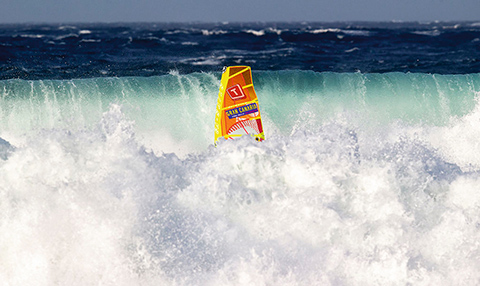
// A typical onshore scenario, wild sea, white horses everywhere like a scene from Poldark, compared to…
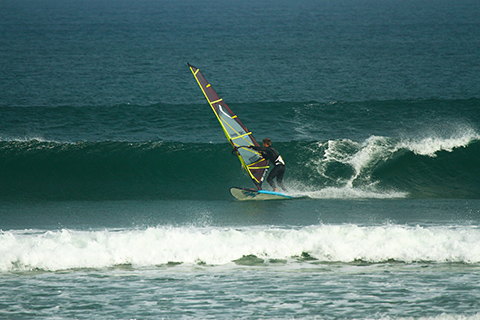
// The offshore wind sea-state – clean rollers rumbling through a glassy sea. But it’s NOT always like that.
Really Onshore.
When you get to the water’s edge and can’t make up your mind whether to launch on port or starboard – that’s really onshore. It’s not ideal.
Getting out.
Depending on the size of the shore-break, it’s difficult to impossible. If you bear away to get going, you hit the beach. You have to launch parallel to the shore and then immediately head up to hit the waves nose first. To keep the speed up and breach the white water without being washed back is very technical.
Holding station.
For all the reasons above, it’s tricky. You get planing along the shore, make 20m upwind; then a wall of white water catches the upwind rail, washes you back in and you find yourself 200m from where you launched. As soon as you catch a wave, on purpose or not, you’re going downwind.
In really onshore winds you can’t use the wave to carry you back upwind. As soon as you catch one, you’re losing ground.
Jumps.
It’s difficult for the same reason as getting out – you have to head right up to hit the wave nose first. As you do so, you lose speed and lift, the sail closes, you get blocked over the centre-line, can’t use the feet scissor action to bear away and flop down tail first into wind and stop.
Riding
The hurdles are many – the possibilities few.
1. As you bear down it, you’re on a very broad reach, where it’s hard to control speed and power. If the wave is big, it shelters the wind as you drop down, at which point you become mush fodder.
3. The sexy backside riding moves like the lay-down ‘snap’ off the top, are also tricky because it involves carving all the way back up the wave to point the nose at the wind. As for front-side riding, it’s a complete clew first exercise.
Kit Choice
In all wind and wave situations, your first priority has to be to get out. In direct onshore winds that means beating. It’s a constant battle against both wind and wave and the only way to win that struggle is to arm yourself with power, speed and resistance – a little extra sail, a little extra volume, bigger fin(s) and perhaps favour the earlier planing freestyle wave over the wave board.
Where you really need that power is in the shore-break where the wind is often a force lighter, so you need to rig big and for most of the session embrace the feeling of being maxed out.
To summarise
I haven’t sold it to you have I? If the wind is light and the waves closely spaced and dumping on the shore, there’s no point. Even if you manage to get out, there’s nothing to do when you get out there. But if the wind is strong and the waves are small and crumbling gently over a shallow shelving beach, you can scream up and down on the flat patches in between, hopping, popping and banking off the walls as the mood takes you. I had such a session in a 25 knot westerly at Saunton Sands last month. Was it wave sailing? Not really – but it was a lot of fun and an option if you really couldn’t find a spot with a more friendly angle. Sometimes OK for a bump and maybe a jump. The best manage to rip in Sylt but not without a heap of mishaps. It’s generally to be avoided.
Side Onshore
It’s what 90% of wave sailors encounter 90% of the time. Waves are generated and blown along by the wind. Only over big, deep open oceans do the waves roll beyond that wind and become swell. For most, the nearest wave sailing option is to launch off shores that face the prevailing wind and sail on the waves generated by that same wind – but we select a spot on the beach where the wind strikes it at an angle. As the waves make contact with the seabed inshore, they bend in to break parallel with the beach. That small difference in wind and wave angle not only makes life a lot easier but also opens up a heap of jumping and riding possibilities.
Getting out
You have room to bear away to get planing, can sail out across the wind and hit the waves nose on. That’s the theory. However, side onshore winds tend to bend in towards the shore, making them more onshore by the beach where you launch, meaning you have to bear away more than you think. Actually how easy or hard it is to get out depends on the strength of the wind inshore, the spacing of the waves and whether they’re dumping or crumbling.
ONSHORE CHOICES
Onshore conditions are often cast as the poorer, much uglier cousin of offshore conditions. Often they are … but not always. When a proper groundswell combines with a cross on wind, conditions can be glorious.
It depends on whether a sub-aqua hurdle is in place to refract or bring order to those swells. The images show the same wind direction, side on from the right but offering totally different prospects – one survival,
and the other an endless choice of up and downwind riding on glassy faces and jumps.
// A high tide, onshore mess as random wedges of water catch each other up as they run inshore. There are limited gaps between waves to get up to speed and no pattern to the break. You can have some jumping and riding fun but you have to work for it. Don’t expect too much.
// Compare that to the smooth perfection of ‘Mossies’ in SW Ireland. As a groundswell bends in over the reef, the waves spread out and clean up. The 18 knot side on wind is enough to power you into jumps but
not enough to disturb the faces. I can’t tell you how much fun this day was. Everyone was a hero.
WHAT A DIFFERENCE A SHIFT MAKES
Same spot, same state of tide but a 20° wind shift during the day turned a classic side off day into a ‘different’ side on one. The onshore wind chops up the surface, stops the wave walling up, meaning you’ll have
to start your top turn earlier and/or make it lower on the wave if you’re to avoid falling off the back. Some of the group that day failed to relate performance to changing wind and came off the water complaining
they’d lost it. You can only sail as dynamically as conditions permit. But if you alter the tactics and expectations, it can be just as rewarding.
// A marginally side-off wind holding up the faces of an Irish beach break. The longer the faces stay green and the steeper they are, the more you can bury the rail and throw some spray in the knowledge that the wave will project you forward.
// But as the wind swings onshore, it flattens the waves out, sucks the power out of them and messes up the once flat spaces in between. Nothing is made easier by having to carve through chop. Unless you adjust your controls, it feels like you’re getting worse.
Holding station
Reaching out, you don’t have to make a violent change of direction to strike the waves nose first so there’s less chance of being caught broadside and being swept downwind back to the shore. Coming back, the power of the wave allows you to point higher than you could on the flat. The more ‘side’ there is in the ‘side-onshore’ the more you can exploit that upwind conveyor.
Jumps
The jumping capital of the world is Pozo in Gran Canaria where the wind is actually more ‘on’ than ‘side.’ It’s not the perfect direction (more ‘side’ would allow a faster, more nose-on approach) – but what makes it the capital, apart from the god-like standard of the local residents, is the strength of the wind (nuclear) and the fact it blows all the way to the beach – and so allows you to get up to full speed by the time you meet the ramps. For jumping, wind strength and consistency are FAR more important than size of wave. The waves at Pozo are nothing special. A side-on wind tends to be the jumping favourite because, blowing from the sea, there are no obstructions.
Riding
Sailing across the wind back to shore, you naturally ride the waves ‘back side’ – i.e. with your back to the wave. It’s the easiest introduction to surfing a windsurfer; just lean on the heels to carve up towards the wave; pressure the toes to carve back down. However, many get stuck on a kind of ‘just-riding-home’ plateau. It seems hard to get dynamic and throw some spray. You lose power as you bottom turn towards the wind. At the top of the wave you get blocked between an empty sail and the wave and flop back down the wave. The only way to inject some ‘snap’ is to go for the lay-down top turn where you carve hard into wind up the face, lean the rig down the slope, drop on top of it, backwind it and use that resistance to drive the tail round. It’s both technical and ballsy – but LOADS of fun. The more ‘side’ the wind, the more achievable it is. Riding downwind, ‘down-the-line,’ the surfing Holy Grail, is totally new technical ground for many. As you turn parallel with the wave, you’re already through the wind so the whole second half of the ride has to be performed clew first with your feet in the original set of straps. It’s a real test of power control, wind awareness and flexibility.
Kit choice
With jumping being the focus, you’re looking for acceleration and speed independent of the wave. Hence you choose to be powered up on either a wave or freestyle wave board. Many favour a powerful
central fin (single or with thrusters) for jumping because it offers an instant positive reaction as they drive off the tail to take off.
For riding, the main problem as you turn down-the-line is out-running the wave. That, and because wind-driven waves are often ‘slopey’ and slow, means you go for a board with a naturally tight turning circle – wider tail with perhaps a twin or tri-fin set-up (it’s a huge subject!). The turns must be snappier, less drawn out.
To summarise
Psychologically any wind with ‘on’ in the title makes you feel safer in the knowledge that along with all the other jetsam out there, at some stage you’ll end up back on the beach. Just how frustrating/joyful it is depends on how much that wind is affecting the shape and frequency of the waves. The worst onshore session I endured was in a northerly at Ho’okipa. A giant swell was interspersed with random lumps of massive wind chop. The swells were too big to encourage big jumps. You’d flop off the top and then plummet Tom and Jerry style into the void because the gusty 18 knot wind wasn’t enough to support the rig and soften the fall. As for riding, it was mostly a case of trying to outrun hotels of white water over crazy chop, under-powered on a broad reach. My fault for going out – no wonder I was alone. The best was in Kerry at Mossies in Brandon Bay where the reef refracts and cleans up the swell. In a north westerly, you can ride backside and front side across glassy, peeling faces. The swell was fast enough to allow long drawn out bottom turns or ride the lip clew first. It was technical but predictable – and being a reef break, you can take refuge on the flat waters inshore … and Spillanes Pub is but a spit away.
Easiest direction for the basics of jumping and upwind riding – but technically hard to wave ride dynamically, especially downwind.
OFFSHORE – the glorious and the downright dangerous.
Offshore conditions are often visually appealing, but like those sirens on the rocks, they can be deceptive, deceitful and perilous. Really clock the direction – the more offshore it is, the more difficult it is to get out, jump and catch waves. If you’re just riding, strong winds may be a huge disadvantage. The two pics below highlight the wicked and the wonderful. Kerry’s Brandon Bay, 140° offshore, 40 knots (gusty as f***) and a big swell. Really hard to get out, really hard to get on the wave; and if you do get on the wave 40 knots turns to 60 making it impossible to make any turn without being blasted off the back. And if anything broke, you’d be in deep do do until you beached in Newfoundland. On the flip side is Brazil’s ‘Jeri’ where 20-25 knots of solid wind blows a few degrees offshore over waist high friendly, clean ramps. It’s a fine angle for jumping and an even better one for downwind riding and popping those first aerials, which you feel like going for because the curving beach offers a lee shore in the same country.
// The carving 360. It’s all too easy to start thinking about how and where to lay down the rig – but if you stop carving, it’ll never happen.
// Beautifully offshore in Jeri.
Directly (or nearly directly) Offshore
To say you’re wasting your time is a bit strong, but most of the time you are. As with direct onshore winds there is a very poor effort to return ratio.
Getting out.
You have to leave the beach on a run or very broad reach – extremely tricky on a sinky board and in a gusty wind.
Holding station.
Once you’re out you have to beat back. If you can’t make your small board point on or off the plane, you’re in trouble.
Jumping.
It’s nigh impossible since you have to take off way off the wind where it’s hellish difficult to control the power.
Catching a wave
You have to point to shore directly into wind so can’t generate enough speed to catch the wave. If you do, the wave is taking you straight into wind giving you power control problems.
To summarise
One morning in Tarifa I was slaloming around in the direct offshore ‘levante’ by the stadium. After a 200m I spotted a slow, lazy swell, perhaps from a super-tanker, so headed up a few degrees to catch it. I then stayed on that same wave three miles all the way to the Dos Mares Hotel. It was extraordinary – but it wasn’t so much wave sailing as speed sailing with the help of a slope. That’s the best you’re going to get. Only in small waves and strong constant winds could you do anything – there’s usually somewhere better to launch
Side Offshore
Now we’re talking. The less ‘off’ the easier it will be to get out and catch waves. Within 20° of side-shore is perfect. But as with every situation so far, so much depends on the strength and consistency of the wind and the size and regularity of the waves.
Getting out
The plus is that the waves are likely to be more ordered, arriving in sets with bigger gaps and less white water. The minus is that, having been held up by the wind, they fold with more force. The wind tends to be all over the place by the impact zone. Having travelled across land, it’s likely to be gusty anyway. It also accelerates and turns more offshore as it’s squeezed up the wave face meaning you get a blast of power from behind as you climb the lip and then drop into a huge hole on the other side. Initially catapults are a way of life. The tactic is to turn upwind up the face to soften the power.
Holding station
Relatively easy depending how much downwind riding you’re doing. If you catch a wave and head straight to the beach, you make instant ground upwind. If the waves are powerful, you can step out of the straps, park the sail and surf straight into wind back to shore. The big difference between this and dead offshore is that you can reach shore by just sailing across the wind … although not necessarily the bit you launched from.
Jumping
So much depends on the nature and exact angle of the wind. In Jericoacoara for example, it’s strong, only a few degrees offshore, the waves are small and at any one time a flock of freestylers will be contorted 30 feet in the air. It’s jumping heaven. In Punta Preta in the Cap Verdes, where the waves are big and powerful and the wind usually light and very offshore, jumping is nowhere on the agenda.
Jumping in offshore winds does catch people out. You’re often forced to take off slightly off the wind. Jumping is all about getting the nose up by momentarily depowering. That’s hard on a broad reach. You have so much speed and mastfoot pressure it’s all too easy to nose-dive. And having been squeezed up the face, the wind above the wave is often wild and unstable.
Power is hardest to control when you’re broad to the wind, so having the wind behind you on the way out through the waves is no advantage.
GETTING WORSE THEN BETTER WITH SKYEBOY “
The images pumped out of Pozo, the world’s windiest world cup venue where a 3.2 is a common size for big blokes, can seduce you into believing wild is wonderful. But as the wind increases in the waves, the
challenge becomes exponentially harder, physically, mentally and technically. You can’t do a small jump; and to make tight turns on slow waves means your power control has to be exceptional.
// A typical Pozo image. Arguably the more impressive move is Jaeger Stone cracking off the top in a very onshore wind – not possible unless you can sail clew first and switch foot in a force 9. It’s a great spot but not one where you’d go to learn down the line riding. PHOTO John Carter / pwaworldtour.com.
Catching the wave
In onshore winds it’s so easy – just bear away. But no longer. If the wind is light (the best riding conditions are often in non planing conditions) and quite offshore, you have to really work, like a surfer, to catch the wave – stepping forward and throwing the rig forward to drive the nose down the hill and combat the accelerating wind which is trying to blow you off the back. The more offshore the wind, the harder it is to catch the wave.
Riding
This is what you’ve come here for. Upwind, backside riding is nearly impossible. Your natural reaching course back to shore leaves you facing the (hopefully) unbroken wave. Suddenly down-the-line riding makes perfect sense. It’s easy because if you keep the turns shallow, the ride takes place between reach and broad reach on the original tack where the power is easiest to control. You approach the top of the wave just off the wind, the perfect angle from which to exploit the power – this is when you get that first proper off-the-lip or aerial.
Kit
Dilemma, catch-22 and other words suggesting confusion. The board and rig you need to get out (often off the plane) through the break, survive the lulls, maybe uphaul, tack or gybe are not the ones you need to ride the wave with. The hidden skill of the pros is their ability to get out there on tiny kit.
The first habit to acquire is to rig down. If the waves are of any speed and size, as soon as you catch one, they’re carrying you into the breeze and your apparent wind will double. If you can’t sheet in and are fighting the rig, you can’t take up an even footed surfing position on the board and the game ends there.
For pure riding, big board (relatively) and small rig is the way to go. Volume is a welcome psychological safety blanket when the wind is ‘off.’
A wave board carries a hint in its name. Its curves conform to the shape of the wave and allow you to take vertical drops and make tighter turns in steeper places – but that’s the cream. If the waves are not too steep, the glory of the offshore wind is that the conditions are very flattering and pretty much every board (with wave in the title) works so long as you keep the turns shallow.
The first time you go out into offshore winds and a decent swell, it’s like you’ve been asked to rub your tummy and pat your head whilst riding a unicycle backwards – there are so many conflicting forces to deal with.
To summarise
It’s the classic wave-riding direction. But riding is the easy bit. It’s getting out half on and half off the plane, dealing with violent gusts, lulls and shifts in the wind – that’s the real challenge. Habitual blasters, who like to drop their bulk against a meaty foil and feel a strong and reassuring counter-balance, instinctively hate such conditions. It immediately finds out dodgy trimming and balance skills.
Wave-riding heaven if you can get out and catch one; technically challenging and thanks to spending much of the time hooked out, physically exhausting. Tricky jumping. Psychologically testing.
COLLATING THE INFO …
Wave sailing is as much a game of chess as it is acrobatics. Here are certain real life examples that help distil the above information and make it real.
You need power … from somewhere.
To have a good time in the waves you need a source of power to generate speed, which comes from either the rig or the waves. If you have weak wind and weak waves, even the best struggle to do anything exciting. In onshore winds where you’re jumping and riding often on mushy rollers that speed comes from the rig. In offshore winds, and clean, steeper waves, you look to the wave for your speed.
Big wind not always good
Because so much of the time we sail the waves generated directly by the wind, people assess the wind with a ‘the more the better’ attitude. Nuclear winds are good for jumping – but you have to be very good, bold and quick healing. A session that was going well can be tainted by a small increase in wind strength. Extra wind means extra speed. You assume it’s a good thing but in slow waves it can throw your timing right off and force you into long turns on the wrong part of the wave – as well chopping up the face.
You need to disassociate wave-sailing from gale force winds and embrace the notion in some situations of being under-powered. As a coach I’ve seen far more wave-riding improvement when the wind has dropped, at which point people slow down, think like surfers and, without the rig heaving them around, take up far better positions. It’s impossible to wave ride effectively if you’re over-powered.
Those sailing JAWS are typically in 10-15 knots of side-off wind but using just 4.7s. If there was 30 knots, the wind they’d experience shooting down the face would be 50 knots or more – unsailable.
Clocking the direction
If you’re sailing the same spot day to day, it’s the failure to spot the subtle changes in wind direction that causes apparent technique failure.
“My jumps are rubbish today.” If you’ve failed to note a 10° onshore shift in the wind but are still approaching the waves at the same angle, you’ll take off too far into wind and flop back down tail first with no feeling of soaring. Further up the scale a similar swing onshore can suddenly make you crash your forward loops because you’re pulling the trigger too close to the wind.
“I can’t catch a wave today for the life of me. But when I do, I get munched” A 10° offshore shift in the wind will make the waves that much harder to catch, forcing people to catch them later just as they are pitching.
Small changes in wind direction completely alter the timings of wave turns. If it kicks more offshore, you have to start the top turn earlier; and with aerials you’re more likely to be blown off the back of the wave.
If the wind goes more side shore, you’ll be further downwind as you start your top turn increasing the risk of over-sheeting or getting catapulted.
These are all mistakes where the pilot feels he or she has lost it – in fact it’s just down to the weather.
In the next issue I continue the theme, concentrating more on how the change in wave, size, shape, direction and frequency influences your approach. With 4 weeks in Donegal and Tiree coming up where conditions change by the minute, we shall have plenty of examples!
If you want to see living examples of what you’ve read, check out Harty’s SERIOUS ABOUT WAVES DVD series he made with Nik Baker. It’s available via his new website www.peter-hart.com along with news of all of his clinics. Email him for his monthly newsletter on [email protected] or like his Peter Hart Masterclass page.



